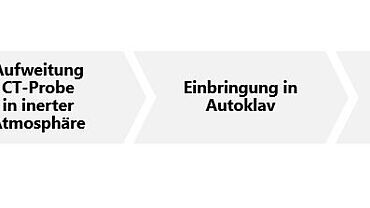ASTM E1681: KIH Test on Metals
The KIH test is a fracture mechanics test to determine the threshold stress intensity factor (KIH) of a metallic material in a hydrogen environment. ASTM E1681 distinguishes between two types of loading: the KIH test with constant displacement and the KIH test with constant force on fatigue precracked CT specimens.
The objective of these KIH tests to ASTM E1681 is to assess the suitability of a metal for use in special pipes and pipelines for hydrogen transport.
Standards Running a test Characteristic values Specimens Related products Request a consultation Hydrogen brochure
Relevant standards for KIH testing
The following standards are applicable for the KIH test and the determination of the threshold stress intensity factor (KIH) in a hydrogen environment:
- ASME B31.12 – Standard on Hydrogen Piping and Pipelines
This standard defines the safety of pipelines and contains requirements for pipelines that transport gaseous and liquid hydrogen. - ASME BPVC.VIII.3 - ASME Boiler and Pressure Vessel Code, Division 3, Alternative Rules for Construction of High Pressure Vessels
This standard contains the conditions for testing in pressurized hydrogen and, depending on the test method, contains further requirements of the calculation KIH. - ASTM E1681 - Standard Test Method for Determining Threshold Stress Intensity Factor for Environment-Assisted Cracking of Metallic Materials
The ASTM E1681 standard specifies the determination of the environment-assisted cracking threshold stress intensity factor parameter KIH in a hydrogen environment.
Performing the test according to ASTM E1681
Prior to running the KIH test, the CT specimen is fatigue precracked using a servohydraulic testing machine. This precracked CT specimen is then loaded in a gaseous hydrogen environment. ASTM E1681 differentiates between two main types of loading: either the specimen is loaded under constant displacement over a specified time period, or it is loaded under constant force. In some instances, this may lead to crack growth or fracture, but that is not always the case.
A testing machine is not required for constant displacement KIH testing (constant displacement). The specimen is bolt-loaded under certain constant displacement in an inert environment. A clip-on extensometer is used to measure the load line displacement of this bolt-loaded specimen. The constant force KIH test requires the use of a testing machine, such as an electromechanical creep testing machine, which loads the precracked specimen with a specified tensile force.
For the constant displacement KIH test a specific workflow must be adhered to:
- Precracking of the CT specimen in a dynamic testing machine
- Load line displacement of the CT specimen in an inert atmosphere with the use of a clip-on extensometer
- Loading of the CT specimen and placing it in the autoclave
- Pressurizing of the autoclave with pressurized hydrogen for 1,000 hours
- Removal of the CT specimen for visual assessment of the fracture surface

Important characteristic values to ASTM E1681
These characteristic values according to ASTM E1681 are used to evaluate the resistance of a metal to hydrogen induced cracking:
- KIH
KIH is the abbreviation for “threshold stress intensity factor”. KIH is defined as the threshold value of the stress intensity factor. - KIEAC and KEAC
EAC is the abbreviation for environmental assisted cracking. KIEAC and KEAC are defined as the highest value of the stress intensity factor, where neither failure nor crack growth occurs. KIEAC is therefore understood as the maximum permissible load on existing notches and cracks that still guarantees safe operation.
Specimen requirements to ASTM E1681
When selecting specimens for KIH testing, it is important to adhere to the size requirements and minimum specimen thicknesses specified in ASTM E1681.
The following specimen shapes can be used:
- Bolt-loaded CT specimens (for the constant displacement KIH test)
- CT specimens (for the constant force test KIH test)